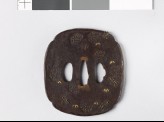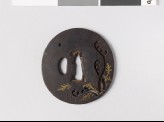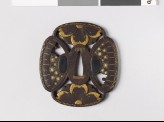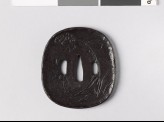The A. H. Church Collection of Japanese Sword-Guards (Tsuba)
An unpublished catalogue of the A. H. Church collection of Japanese sword-guards (tsuba) by Albert James Koop.
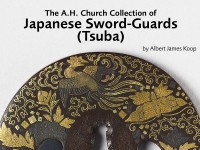
Just as the Miōchin (Group IV) were the premier family of armourers, so the Umetada [Japanese text] were the foremost swordsmiths of their day. Their 18th Master, Shigeyoshi I [Japanese text], is said to have made sword-furniture for the Ashikaga Shōgun (end of 14th century), but none of his work is known. Serious study of Umetada guards begins with the 25th Master, Miōju ([Japanese text], or Shigeyoshi II; b.1558; d. 1631). His headquarters, as also those of the succeeding nine Masters, were at Kiōto, but he was invited to several provincial centres and exerted a lasting influence on the local schools.
A branch founded by Naritsugu (c. 1752) worked at Yedo, while various members of the family were active at other centres. The Umetada style in general is a skilful combination of chiselling and incrustation or inlay, all the usual metals and alloys being employed to that end. Some of the later work was influenced by the hoami (Group XII).
A 19th-century Umetada, Ichiō or Kazuyoshi, signs the first character of the family-name with a plum (ume) blossom. His work displays soft modelling in low relief.
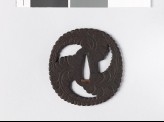 Tsuba with heraldic crest of the Shinjō family (EAX.10192)
Tsuba with heraldic crest of the Shinjō family (EAX.10192)
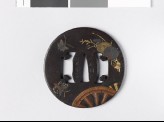 Tsuba with plants, butterflies, and chariot-wheels (EAX.10193)
Tsuba with plants, butterflies, and chariot-wheels (EAX.10193)
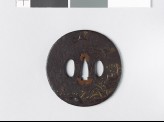 Tsuba with two flying egrets (EAX.10194)
Tsuba with two flying egrets (EAX.10194)
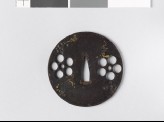 Round tsuba with heraldic mon and scrolls (EAX.10195)
Round tsuba with heraldic mon and scrolls (EAX.10195)
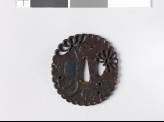 Lobed tsuba with chrysanthemums (EAX.10196)
Lobed tsuba with chrysanthemums (EAX.10196)
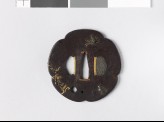 Lobed tsuba with butterflies, a toad, and a gourd-vine (EAX.10197)
Lobed tsuba with butterflies, a toad, and a gourd-vine (EAX.10197)
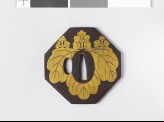 Octagonal tsuba with gosan-no-kiri, or paulownia leaves (EAX.10198)
Octagonal tsuba with gosan-no-kiri, or paulownia leaves (EAX.10198)
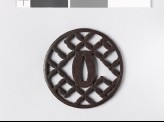 Round tsuba with shippō diaper of interlaced circles (EAX.10199)
Round tsuba with shippō diaper of interlaced circles (EAX.10199)
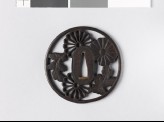 Round tsuba with heraldic chrysanthemum blossoms (EAX.10200)
Round tsuba with heraldic chrysanthemum blossoms (EAX.10200)
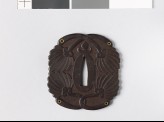 Tsuba with feather fans and gold eyelets (EAX.10201)
Tsuba with feather fans and gold eyelets (EAX.10201)
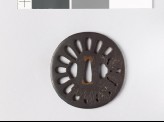 Tsuba with chrysanthemoid florets and dewdrops (EAX.10202)
Tsuba with chrysanthemoid florets and dewdrops (EAX.10202)
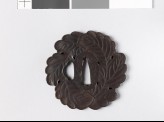 Tsuba in the form of two overlapping oak leaves (EAX.10203)
Tsuba in the form of two overlapping oak leaves (EAX.10203)
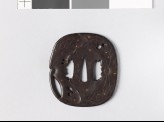 Tsuba with lotus leaves and dewdrops (EAX.10204)
Tsuba with lotus leaves and dewdrops (EAX.10204)
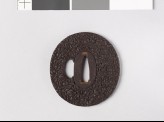 Tsuba with peony flowers (EAX.10205)
Tsuba with peony flowers (EAX.10205)
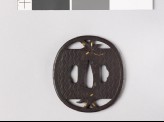 Tsuba with two maple leaves (EAX.10206)
Tsuba with two maple leaves (EAX.10206)
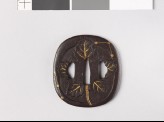 Tsuba with symbols of poem-writing at the Tanabata Festival (EAX.10207)
Tsuba with symbols of poem-writing at the Tanabata Festival (EAX.10207)
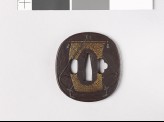 Tsuba depicting a property boat used in nō drama (EAX.10208)
Tsuba depicting a property boat used in nō drama (EAX.10208)
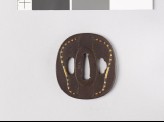 Tsuba with two bows (EAX.10209)
Tsuba with two bows (EAX.10209)
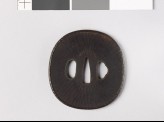 Tsuba with radial lines (EAX.10210)
Tsuba with radial lines (EAX.10210)
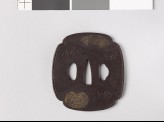 Mokkō-shaped tsuba with fan mounts depicting a phoenix and a unicorn (EAX.10211)
Mokkō-shaped tsuba with fan mounts depicting a phoenix and a unicorn (EAX.10211)
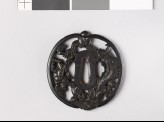 Tsuba with a hare, dragon, and tiger (EAX.10212)
Tsuba with a hare, dragon, and tiger (EAX.10212)
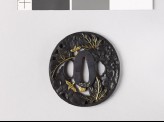 Tsuba with peonies (EAX.10213)
Tsuba with peonies (EAX.10213)
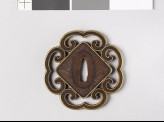 Tsuba with roped edges and heraldic devices (EAX.10214)
Tsuba with roped edges and heraldic devices (EAX.10214)
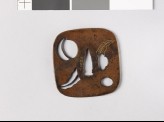 Tsuba with peach and leaves (EAX.10215)
Tsuba with peach and leaves (EAX.10215)
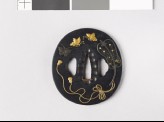 Tsuba with a Chinese fan and butterflies (EAX.10216)
Tsuba with a Chinese fan and butterflies (EAX.10216)
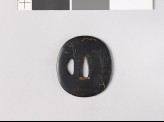 Tsuba with broad bean, leaves, and tendrils (EAX.10217)
Tsuba with broad bean, leaves, and tendrils (EAX.10217)
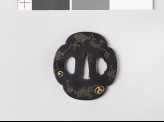 Mokkō-shaped tsuba with swastikas (EAX.10218)
Mokkō-shaped tsuba with swastikas (EAX.10218)
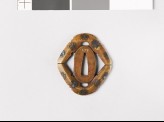 Tsuba with cherry blossoms (EAX.10219)
Tsuba with cherry blossoms (EAX.10219)
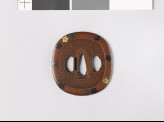 Tsuba with family crests of the Aoyama of Sasyama and the Hosokawa of Higo (EAX.10220)
Tsuba with family crests of the Aoyama of Sasyama and the Hosokawa of Higo (EAX.10220)
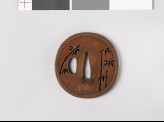 Tsuba with bamboo and cherry blossoms (EAX.10221)
Tsuba with bamboo and cherry blossoms (EAX.10221)
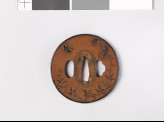 Round tsuba with peonies and butterflies (EAX.10222)
Round tsuba with peonies and butterflies (EAX.10222)
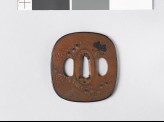 Tsuba with autumn flowers (EAX.10223)
Tsuba with autumn flowers (EAX.10223)
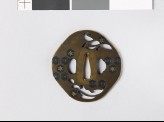 Tsuba with an orchid and hexagons (EAX.10224)
Tsuba with an orchid and hexagons (EAX.10224)
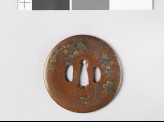 Tsuba with grape vine (EAX.10225)
Tsuba with grape vine (EAX.10225)
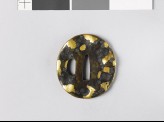 Tsuba with plum blossoms and dewdrops amid snow (EAX.10226)
Tsuba with plum blossoms and dewdrops amid snow (EAX.10226)
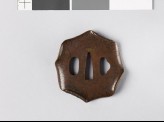 Octagonal tsuba in the form of a lotus leaf (EAX.10227)
Octagonal tsuba in the form of a lotus leaf (EAX.10227)
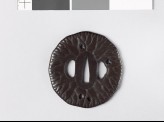 Tsuba in the form of a lotus leaf (EAX.10228)
Tsuba in the form of a lotus leaf (EAX.10228)
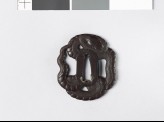 Mokkō-shaped tsuba in the form of a coiled snake (EAX.10229)
Mokkō-shaped tsuba in the form of a coiled snake (EAX.10229)
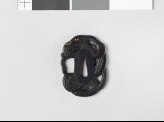 Mokkō-shaped tsuba in the form of a coiled snake (EAX.10230)
Mokkō-shaped tsuba in the form of a coiled snake (EAX.10230)
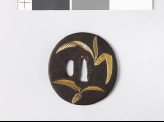 Tsuba with cycad leaves and a radish (EAX.10231)
Tsuba with cycad leaves and a radish (EAX.10231)
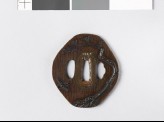 Tsuba with plum trees and flying birds (EAX.10232)
Tsuba with plum trees and flying birds (EAX.10232)
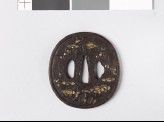 Tsuba with blossoming plum tree (EAX.10233)
Tsuba with blossoming plum tree (EAX.10233)
Notice
Object information may not accurately reflect the actual contents of the original publication, since our online objects contain current information held in our collections database. Click on 'buy this publication' to purchase printed versions of our online publications, where available, or contact the Jameel Study Centre to arrange access to books on our collections that are now out of print.
© 2013 University of Oxford - Ashmolean Museum

